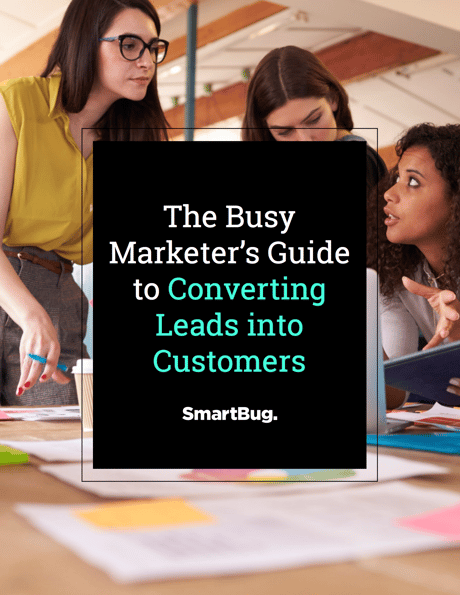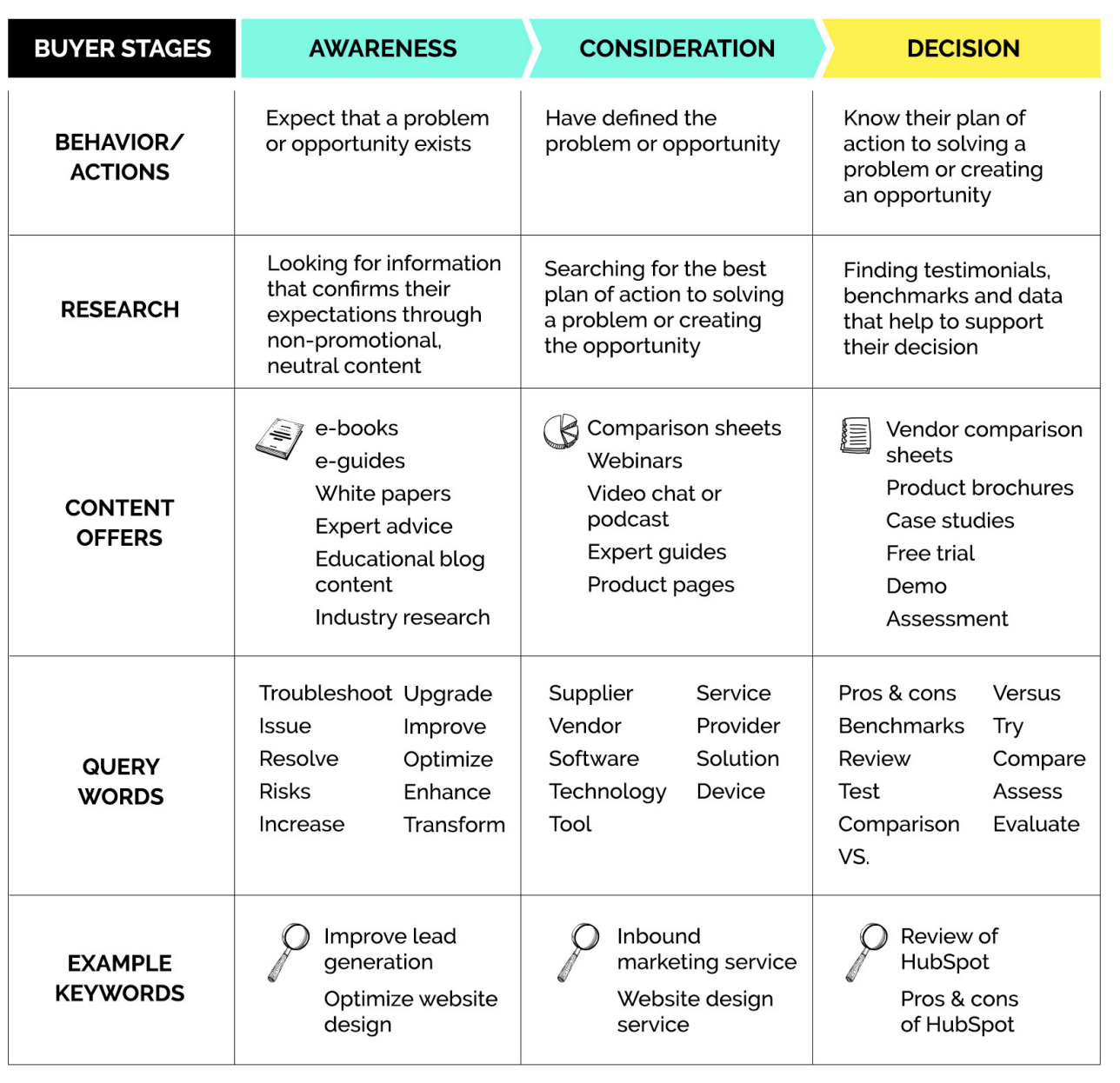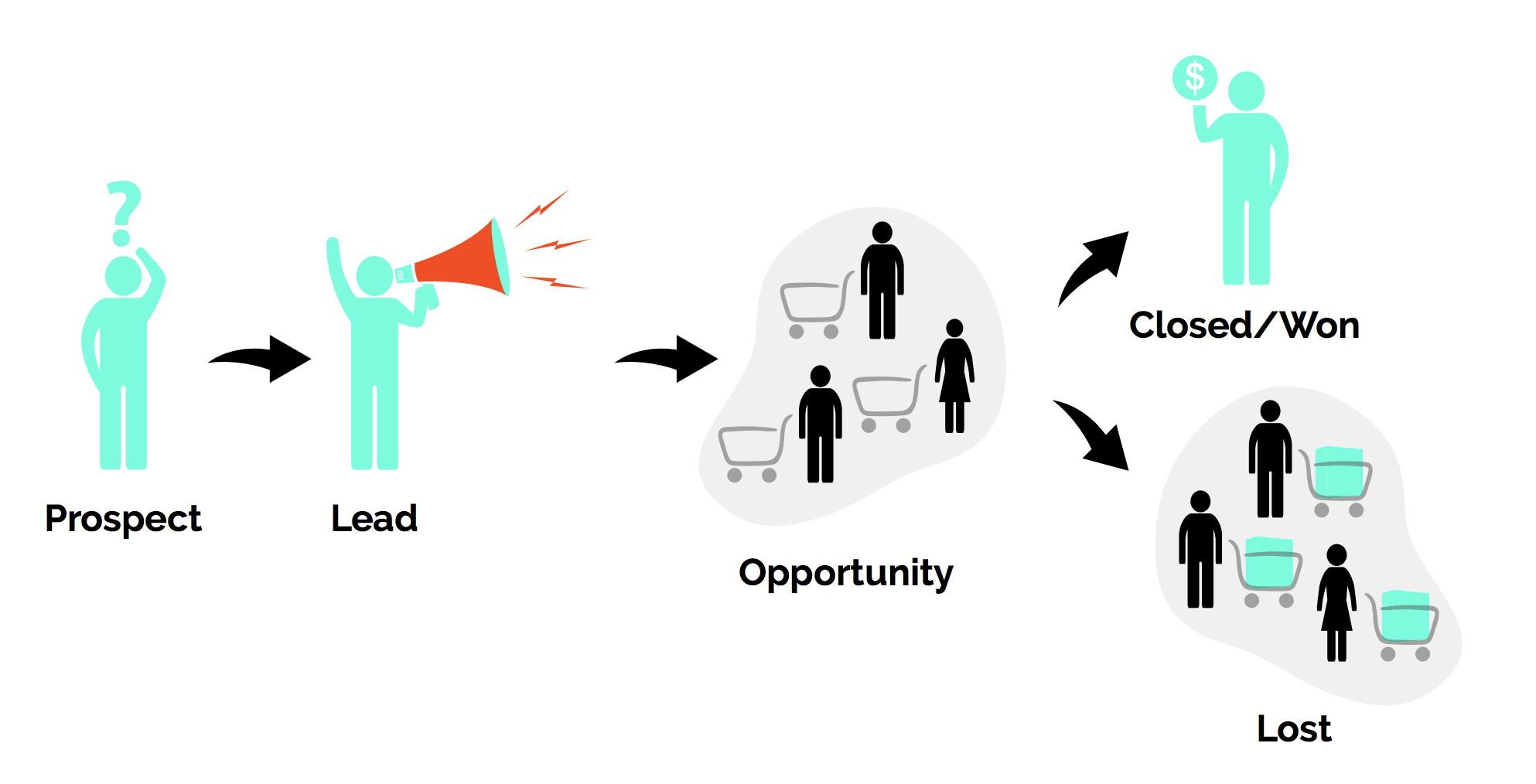
The Busy Inbound Marketer’s Guide to Converting Leads into Customers
You’re getting traffic to your website and your leads are flowing in, but how do you find and hand off the most qualified leads to your sales team? How can you be sure that those leads are going to turn into customers? How can you prove marketing played a part in the success?
Save This PDF to Come Back to in the Future
You can download this guide as a PDF using the form here, or you can keep reading about what to do with leads once they enter your funnel, how to build an effective lead nurturing campaign, the basics of lead scoring, and improving the marketing and sales relationship

Chapters
The Journey from Lead to Customer
Lead Nurturing: How to Convert Leads into Clients
8 Steps for a Great Lead Nurture Campaign
How to Implement Lead Scoring for Sales
Why You Should Track Customers
Reporting on Your Marketing Efforts
The Journey from Lead to Customer

The Journey from Lead to Customer
The buyer’s journey consists of three stages:
- Awareness
- Consideration
- Decision
Its main purpose serves as a way for marketers to logically map content to the mindsets of contacts at any given moment in the process.
Here’s the chart for quick reference again:

In this chapter, we will discuss the decision stage of the buyer’s journey and what you need to completely understand the leads that live within that stage.
The Decision Stage Problem
As you can see from the chart, buyers in the decision stage of the journey have decided you are most likely the solution for their problem, but need more information to support this decision.
As inbound marketers, we offer content such as testimonials, case studies, free consultations, demos, and so on, so the buyer can see exactly why you’re the perfect fit. But what happens when the lead decides to request a demo or consultation from you?
Most marketers send the lead directly to sales, and think “Great! Another marketing qualified lead (MQL) to add to my list of achievements!” But wait—is that lead actually qualified? Most of the marketers SmartBug Media™ talks to don’t really know.
They see a decision stage lead come into the funnel and they send it to sales, no questions asked.
While the above approach works when you have a minimal amount of leads, it isn’t sustainable. Sales will get overwhelmed with inbound leads. How a salesperson spends their time on the phone is extremely important.
If all of their time is spent calling unqualified demo requests, what good has marketing really done for them?
While content requests and form submissions are a good starting point, you must think beyond the decision stage of the journey and train yourself to segment leads based on the needs of the sales team rather than the type of content downloaded alone.
Sales will get overwhelmed with inbound leads. How a salesperson spends their time on the phone is extremely important.
The Buyer’s Journey vs. Sales Funnel Stages
What does the sales team think of your leads? Do you know what they considered to be qualified? In what stage of the sales funnel does the MQL land on their radar?
All of these questions can be answered by understanding the sales funnel. Like the buyer’s journey, the different sales funnel stages help your sales team understand how close to buying a lead is compared to the rest of the pack.
Often, the sales funnel and the buyer’s journey overlap, but it can be confusing because you and your sales team aren’t calling them the same thing.
Prospect
Similar to subscriber, these are contacts that have shown mild interest in your company but aren’t technically close to buying. Blog subscribers fall into this category.
Lead
These contacts are a bit more serious. They have downloaded a piece of content from you, showed interest at a trade show, and so forth. But you don’t have the full story yet.
Marketing Qualified Lead (MQL):
Leads that have shown more interest by requesting a decision stage offer, providing a phone number, and downloading other pieces of content, and who have the requirements agreed upon by sales. They may not be hot yet, but there are no signs or red flags showing that they are disqualified to be in the funnel.
Sales Qualified Lead (SQL):
These are hot leads that the sales team has qualified themselves. Budget, Authority, Need, and Timeline (BANT) has been established. Typically when segmented correctly, MQLs turn into SQLs.
Opportunity
Sales has contacted or met with the lead. The decision maker has been established and is involved in the ongoing communication. There is also a clear timeline to purchase. There may be other sub-stages such as Opportunity 1, Opportunity 2, Opportunity 3, and so on.
Closed/Won
Opportunity became a customer.
Lost
Opportunity did not become a customer.
Important Note: The above list of stages is general. The sales funnel is not the same for every organization. Your sales and marketing teams should work together to define exactly how you look at your leads database, which stages you use, and where each team comes into play.
Understanding what happens to your leads after they are handed off to sales is extremely important.
The qualification process starts the moment a prospect becomes a lead. Marketing can help take some pressure off of sales by identifying the most qualified earlier in the process.

Sales and Marketing Alignment: Sales Funnel Stages
The only way to truly understand the sales funnel is to meet with your sales team and establish rules for qualifying a lead. In our e-book The Evolution of the Sales and Marketing Relationship, our VP of Client Services, Amber Kemmis, details how to have this meeting effectively.
To help you get started, here are questions that you should ask during the meeting:
- How do you define the sales funnel?
- Where does the sales funnel overlap with the buyer’s journey?
- What characteristics define a qualified lead
- What characteristics define a bad lead?
- What is your process after given an MQL?
- Do leads have the right expectations set about what they will be receiving?
- What do leads love and hate about our offers?
- What questions do leads ask you about our services?
- What is the top reason an opportunity is lost?
- What is the top reason a lead closes and becomes a customer?
Other things to accomplish in the meeting:
- If you haven’t already, agree upon your buyer personas. You must have personas to market effectively.
- Set up a monthly meeting to review goals and outstanding items.
- The goal of the meeting is to find out exactly how sales thinks about leads and customers. When you understand their process, your process will become more sophisticated. Form fields will be better defined, emails more personalized, and messaging more targeted to the persona.
Lead Nurturing: How to Convert Leads into Clients

Lead nurturing allows you to automatically follow up with leads based on lead intelligence such as form submitted, behavior on the website, qualified contact details and demographics, and so on.
Without lead nurturing, the likelihood of sales receiving quality leads from you is slim, which means fewer leads become customers. Fewer customers mean less ROI to show from marketing.
Once you have a solid understanding of the needs and desires of your sales team, you can incorporate what you learn into your lead nurturing campaigns to appeal to your leads.
Not sure how to appeal to your leads? Think of it like dating!
Like dating, lead nurturing isn’t a one-size-fits-all approach. You have to test different ideas on different segments of leads. You need to appeal to the person you are requesting more information and visits from, and above all else, you need to personalize your content.
Let’s break down the dating scenario a bit more:
Stage 1: Two People Meet for the First Time
You’re out with your friends and you gaze upon the most beautiful person you’ve ever seen. You walk over, introduce yourself, and enjoy a quick conversation about who you are on the surface, what you do, where you’re from, and so on. Basically, you are both collecting information about whether you will need each other after this conversation.
In Marketing: This is the stage in which someone comes to your website through organic, paid, referral, or social media channels. Make sure you have calls to action on every page of your website, so that if the person visiting is interested in what you have to offer, it is easy to take the next step down the buyer's journey.
Stage 2: The First Date
Great news! The person liked you!
This wonderful individual gave you their contact information and wants to meet you again. You feel the same way, send an email, and make plans for dinner. You go on a date and talk about things that are a little more personal, and that’s OK.
Remember: Don’t get too personal here.
In Marketing: A prospect fills out a form on your website and provides their contact information in exchange for an awareness stage offer. They are still not ready to buy but want to learn how they can find a solution to their problem. The gut reaction is to get them on the phone, but wait! Instead, follow up in your campaigns with more educational materials that would be useful to them. This will ensure you’re building trust with your leads through thought leadership.
Stage 3: After Dating, You Decide to Become a Couple
Things have been going well for a while. Your new partner visits you all the time, you’re dating frequently, and you two love what each other has to say about the world you live in.
Your new love starts to think you may be the one but needs to find out if you align on a deeper level. You’re starting to ask the right questions, and your partner starts to believe you may be the one.
In Marketing: A lead downloads your consideration stage offers and starts to compare you to other similar products or services that could also solve their problem. They think you’re the one, but they want to be sure. Help them make their decision by providing case studies, comparison charts, testimonials, and so on.
Stage 4: You Propose and Get Engaged
Now that you both know each other extremely well and are excited to talk about your future together, you can start planning the wedding.
How much will it cost? Will you need a large attendee list? Will there be a sit-down or buffet-style dinner? How much time will it take?
It’s important to remember that while you’re engaged and you’ve decided that you are great for each other, things can change. So, let them know you care and that you’re willing to work with them, but also evaluate whether or not you can spend the rest of your life with this person.
In Marketing: Your decision stage offers like quotes, consultations, or demos are your most promising for sales. Request a bit more information on your forms, like a phone number or other fields that will help qualify the lead before sending to sales. Remember: The lead still isn’t ready to buy, but they are very close. The more you qualify them and get to know more about their persona, the better chance sales has at closing the deal.
It’s important to remember that while you’reengaged and you’ve decided that you aregreat for each other, things can change.
Stage 5: You’ve Met Your Soulmate and You’re Married
You did it! You pulled off the wedding within your budget and are living happily side by side. You are certain this person is the right person for you, too. And do you know why you were successful? Because you didn’t pressure your partner into committing too soon. You started off easy and then gradually became more and more serious to the point where it made sense to get married. You also made sure that what they wanted matched what you had to offer. You’re married to the right person. You also didn’t ask the person out and then propose on the first date, which is key here.
In Marketing: They become a customer.
Conclusion
If you start to think about your leads as real people with personalities, hopes, and desires, you will connect more and learn far more about their needs.
When you know what your leads need at each stage of the buying process, you will be less likely to send BOFU offers too early.
You will also know whether or not a lead is a good fit for your company earlier on and sales will receive more qualified leads as a result.
Lead your leads down the path, woo them, get to know them, get engaged, and then get married.
8 Steps for a Great Lead Nurture Campaign

Step 1: Establish the Stage of Buyer’s Journey
For example, a campaign for an awareness stage offer should not start with “REQUEST A DEMO!”
Why? Logically, it doesn’t make sense.
If I’m a lead in the awareness stage, I will need more nurturing to get me closer to the demo. You may even send me more awareness stage offers before moving into consideration stage offers, depending on the length of the sales cycle.
Step 2: Identify Which Persona You’re Targeting
Buyer personas should affect everything you do in marketing including lead nurturing campaigns.
Your messaging in your emails and personalization tactics should be targeted to the persona in each stage of their buyer's journey.
For example, if you sell red shoes to the public and you have two personas, Running Reid and Dancing Darla, you would not want to nurture them the same way.
By segmenting your personas and delivering the right content to them, you will help sales obtain more qualified leads.
Step 3: Set Goals for the Nurture Campaign
Not all lead nurturing campaigns are created equal, which means not all goals should be the same for every single campaign.
For example, if you have a very soft awareness stage offer, such as a worksheet, and you enroll leads that download that offer into a campaign, the goal should not be to get them to request a demo. It is too soon. It would be more worth your while to get those leads to convert in the consideration stage where you can nurture their more specific needs.
Often marketers live in a world where the decision stage matters more than the other stages. Get out of that mindset. All stages are important and need to be handled with care. An awareness stage lead will surely become a decision stage lead in good time. It will not happen overnight, but with tailored messaging and properly aligned goals, you’ll be sending qualified leads to your sales team soon enough.
You can also help sales by making it a goal to create a reengagement offer, then setting up a campaign to re-nurture those leads back into an active status.
Step 4: Map Your Nurture Campaign Strategy
Once you’ve nailed down your personas and goals for the nurture campaign, you should map out the content you will be delivering in the campaign. This includes:
- The logical pathway to get your lead from point A to point Z following the buyer’s journey
- When your lead will be taken out of the campaign via other form submissions, becoming inactive, and so forth
- The content needed throughout the entire process
- What content, if any, will interfere with this campaign, and how to adjust for that in the settings
Step 5: Decide on the Number of Emails and Their Types
The number of emails varies greatly depending on what stage of the buyer’s journey your lead is in.
For example, an awareness stage lead will most likely have far more emails than a decision stage lead in the campaign. However, no campaign should have more than eight emails.
If you haven’t gotten to the point in eight emails, you need to rethink your strategy and goals of the campaign.
After deciding the number of emails, decide how you will represent your company in them. Will they be plain text from a salesperson? Marketing emails with beautiful graphics? A mixture of both? There is no right answer to this step. It all depends on the goal of your campaign, how you brand yourself, and how your leads respond to various kinds of emails. It may even differ by persona. It might take some research, but once you figure this step out, it will be easier to build out the campaign.
Step 6: Plan the Timing of Each Campaign
A question SmartBug Media is asked often is, “How long should I delay my emails?”
There isn’t one concise answer to give you. It all depends on your sales cycle, the type of campaign you’re running and what your leads typically respond to.
Again, you may have to test a few different options before deciding on timing that works best for your company. To start, try separating the emails in two-day delays. If that doesn’t work, try and space them out a bit more. Never send more than one email a day.
Step 7: Test the Nurture Campaign Before Launching
It never hurts to have a second, third, or fourth set of eyes when sending out a campaign to your customers.
Doublecheck the links, check for typos, make sure your message is clear, and see what your colleagues and peers think of your strategy and messaging.
Step 8: Run, Analyze, and Tweak Your Campaign
How is your nurture campaign doing? Is it meeting those goals we set in Step 3?
You should analyze the performance with these key metrics and benchmarks.
- Click-through rate (3–5%)
- Conversions for each landing page
- Unsubscribe rate (less than 1 percent)
Common adjustments are:
- Subject line
- Frequency
- Copy/body of email
- Value proposition
- Offer
How to Implement Lead Scoring for Sales

How to Score Leads for Sales
Lead scoring is a tool used to help marketing communicate to sales which MQLs are most likely hot and which leads can be given a bit more time. It is extremely useful when done correctly.
Marketing automation tools like HubSpot help marketers integrate this system with their CRM and offer custom lead scoring capabilities so that you and your sales team set the parameters.
![]() NOTE: Lead scoring is typically used for companies that have an overwhelming amount of leads and marketing needs to help sales sort them. If you get 10 leads a month, the lead score is done manually, so to speak and you can skip this step for now.
NOTE: Lead scoring is typically used for companies that have an overwhelming amount of leads and marketing needs to help sales sort them. If you get 10 leads a month, the lead score is done manually, so to speak and you can skip this step for now.
How Lead Scoring Works
In the simplest terms, lead scoring systems rank leads according to the behavior, action, or characteristics logged in contacts’ properties within the leads database. Those who have the most qualified attributes get the highest score.
The lead scoring system adds up those values for each lead, based on what is recorded in the database, and calculates the overall lead scores based on the findings.
The calculation can also include negative actions such as unsubscribing from email.
The sales and marketing teams also decide together if any additional weighting is necessary for particular attributes such as stage of the buying cycle. The weighting adds an additional fine-tuning to the lead score but isn’t necessary all of the time.
Attributes commonly scored are:
- Content downloaded (individual and total)
- Number of pages viewed on website
- Job title
- Role at company
- Frequency of visits
- Key pages visited (such as Pricing)
- Unsubscribes
- Comments on blog
- Timeline to purchase
- Persona (can be positive or negative)
5 Steps for Implementing Lead Scoring
Now that you know what lead scoring is and why it is important for achieving growth in lead-to-customer conversion rates, here are the steps needed to actually implement your own lead scoring model.
Step 1: Meet with the Sales Team
Similar to your sales process discovery meeting, you should set up a meeting with sales to figure out what key attributes should be scored to help them qualify leads better. Remember to ask how personas play into your lead scoring model. What personas and what qualifications lead to the highest valued closed customers?
Step 2: Develop a Scoring Matrix or Scorecard
A scoring matrix should be a table that plots out what you’re scoring, the value of all criteria, and the number of points it takes to end up in a stage of the buyer’s journey or sales funnel.
For example, is a lead with 200 points marketing qualified? What if they have 300 points? What actions do they have to take to make sure they fit the qualification specifics given by the sales team? This process will take you the longest to complete in creating your lead scoring model.
Step 3: Double-Check Your Lead Scoring Logic
The key to great lead scoring is ensuring your logic works. Is the demo scored too high, making everyone ultra-qualified? If it is, refine, refine, refine. The key, again, isn’t to make every demo request the most qualified. It is to help sales decide which demo request they should call first.
Step 4: Add to Your Tool and Test
In HubSpot, setting up lead scoring is easy. You should take your logic, set up the lead scoring tool and then run it for a couple of weeks.
Is it working? Does it sync to your CRM system? Is the sales team actually using it?
If the answer to any of the questions above is no, you should re-evaluate why it’s not working, and in some cases, if lead scoring is actually that useful to your team.
Step 5: Refine Your Efforts
Set up a meeting every quarter to discuss any refinement that needs to happen in the lead scoring process. Is it working? Is it not? Why or why not? Is there anything new that needs to be scored? You get the idea. Take what you learn from this meeting, set it up again in the tool, and test to make sure it works. Continue this process each quarter.
By implementing a needed lead scoring strategy, you can ensure that your sales team gets the hottest marketing qualified leads. This not only keeps both teams happy, but it also allows you to show proof that your marketing efforts are worthwhile.
Sales and marketing teams work together to decide how much action, characteristic, or piece of content is worth.
Why You Should Track Customers

Why You Should Track Customers
Many SmartBug Media clients struggle with tracking customers. Maybe their sales team has a proprietary CRM that has not been integrated with HubSpot? Maybe the marketer doesn’t quite understand Salesforce and therefore hasn’t integrated it with HubSpot? Maybe the company itself just doesn’t do a very good job at tracking customers? Whatever the case, this problem is important to solve. Without a solution, it is difficult for marketers to prove to their CEO how relevant their efforts are and exactly how much revenue they are driving for the company.
Below are best practices for ensuring customers are tracked in your marketing automation software.
Tip 1: Integrate Your CRM and Marketing Tool
As mentioned previously, this is the easiest solution for many. HubSpot integrates seamlessly with Salesforce (the most widely used CRM). Sales should be tracking customers there. If they aren’t, find out why, see if it is possible for them to do so, and HubSpot will automatically track it. If you do not have a CRM tool, HubSpot now offers a free CRM with Pro and Enterprise packages to help your sales team manage their time and open the communication between teams better. This makes the CRM and marketing tool completely integrated with no APIs or other technical jargon. It simply works.
Tip 2: Get a Customer List Monthly
At the end of the month, ask your sales manager for a list of customers closed that month. You can upload them into your marketing tool as customers. In HubSpot, as long as the email address matches, it will link the contact, mark them as a customer, and then you can segment based on origination of the lead. The more leads that came from organic search, email, referrals, and social media, the better.
Tip 3: Ask If You Do and Can Track Customers
Often, marketers forget to simply ask if the company doesn’t track customers. And if they already know they don’t track customers, they don’t ask why or if it would even be possible to do so. If you don’t ask, you’ll never have the opportunity to gain insight into the revenue you are generating for your company. There are solutions to customer tracking; you might have to be a little creative, but a solution is possible.
Tip 4: Close Them Yourself
Many marketing automation software tools allow you to go into the contact property record and close a lead as customer to help you track.
One client made friends with the lead salesperson; he would send her the names of his closed/wins for the week, and the client would log into HubSpot, find the name of the lead, and then close them as a customer. Sure, a list would be easier, and no, you’re not getting all of the data, but some data is better than no data. Once the client was able to prove she was helping a leading salesperson, other salespeople started to follow suit, and now the company always tracks customers.
The moral of the story: If you don’t try to track, you won’t track. So, start tracking!
Reporting on Your Marketing Efforts

Reporting on Your Marketing Efforts
Fifteen percent of marketers tie their inbound results directly to either company revenue or customers/wins generated.
Fifteen percent? That’s not enough. More marketers need to start tracking customers and revenue to prove just how much inbound marketing has affected the company’s revenue, starting with you.
While revenue is important, there are other metrics to consider in your review. Below is a breakdown of the most important to include in your monthly, quarterly, and yearly reporting.
Month-over-Month Growth
To calculate month-over-month (MoM) growth, complete the following calculation for each metric listed below:

Reach
Ultimately, not growing your reach is a huge problem because you will not be able to focus on what really matters to the CEO: lead generation. Knowing your reach will help you show your CEO how much you are growing your network and focus on the things that matter most.
To track reach on Hubspot, use the Social Reach tool to determine your total reach for social media and add that to the number of email addresses in your database. Then, look at the MoM growth for each channel. Do you notice any trends in growth for a particular channel?
Visits
The total number of visits to your website tells you how your various marketing sources are performing. Growth in visitors is the metric that shows your content is successful. If you are growing the content on your website, the total number of visitors should be growing too. A company blogging at least three times a week can expect to see 10-13 percent MoM traffic growth.
Lead Conversions
Tracking MoM growth on lead conversions in Hubspot can also be done using the sources tool. Once again, you will compare MoM growth for the total number of leads from all sources, and then you can break it down by the same channels as you did for visits. Your benchmark for lead conversion MoM growth should be 2 percent for overall site traffic.
Customer Conversions
Customer conversion is important and becomes even more important to your CEO when you use that metric to calculate the revenue generated from customers in each marketing channel. Although HubSpot doesn’t have revenue tied into the sources tool, you can easily track this by exporting your CRM data into a spreadsheet and stacking up the dollars next to your customer conversions, which are also captured on the sources tool like lead conversions are (if you have your CRM integrated with HubSpot).
Total Visit, Lead, and Customer Count
In addition to growth, you should also track how many visits, leads, and customers you received monthly, quarterly, and yearly. Were the numbers close to the goals you set for yourself? If not, what happened? You should lay out a high-level why and what we’re fixing slide in your reporting presentation to addresses any failures.
Customers via Channel
What you want to know from this metric is how many different leads you’ve closed into customers. In addition to knowing the number of customers you’ve recently gained, look into the reporting tool to see how the customers found your website. Was it a social media post that pushed them into the funnel? Or maybe it was a blog post that the customer found organically via Google? Knowing your customers by channel helps you understand what’s working and what’s not.
Cost per Lead
Not only do you want to measure the customers you’ve gained with inbound marketing, but also you want to see how much you’re spending per lead. Some cost areas to consider when calculating cost per lead: marketing time, creative time, software, and other general overhead costs. Simply take the total spend on inbound marketing for the length of the campaign, divide by the number of leads gained during that time, and you have your cost per lead. The lower the cost per lead, the better you will look. Bottom line: The more leads and customers you can attribute to your inbound marketing efforts, the more valuable your company’s leadership will find you and your efforts. Dig into the numbers and find a way to prove that what you’re doing is worthwhile.
In addition to growth, you should also track how many visits, leads, and customers you received monthly, quarterly, and yearly.
Resources
Download the Busy Marketer's Guide to Converting Leads Into Customers!
Simply fill out this form to receive a PDF version of our guide.


